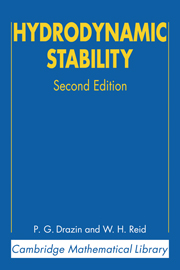Refine search
Actions for selected content:
8126 results in Fluid dynamics and solid mechanics
Contents
-
- Book:
- Internal Gravity Waves
- Published online:
- 05 October 2014
- Print publication:
- 02 September 2010, pp vii-xii
-
- Chapter
- Export citation
Dedication
-
- Book:
- Internal Gravity Waves
- Published online:
- 05 October 2014
- Print publication:
- 02 September 2010, pp v-vi
-
- Chapter
- Export citation
3 - Internal waves in uniformly stratified fluid
-
- Book:
- Internal Gravity Waves
- Published online:
- 05 October 2014
- Print publication:
- 02 September 2010, pp 141-212
-
- Chapter
- Export citation
Frontmatter
-
- Book:
- Internal Gravity Waves
- Published online:
- 05 October 2014
- Print publication:
- 02 September 2010, pp i-iv
-
- Chapter
- Export citation
4 - Nonlinear considerations
-
- Book:
- Internal Gravity Waves
- Published online:
- 05 October 2014
- Print publication:
- 02 September 2010, pp 213-261
-
- Chapter
- Export citation
2 - Interfacial waves
-
- Book:
- Internal Gravity Waves
- Published online:
- 05 October 2014
- Print publication:
- 02 September 2010, pp 74-140
-
- Chapter
- Export citation
Index
-
- Book:
- Internal Gravity Waves
- Published online:
- 05 October 2014
- Print publication:
- 02 September 2010, pp 367-377
-
- Chapter
- Export citation
A - Suggestions for further reading
-
- Book:
- Internal Gravity Waves
- Published online:
- 05 October 2014
- Print publication:
- 02 September 2010, pp 357-366
-
- Chapter
- Export citation

A First Course in Continuum Mechanics
-
- Published online:
- 01 September 2010
- Print publication:
- 17 January 2008

Hydrodynamic Stability
-
- Published online:
- 06 August 2010
- Print publication:
- 05 August 2004
11 - Species and Charge Transport
-
- Book:
- Micro- and Nanoscale Fluid Mechanics
- Published online:
- 05 June 2012
- Print publication:
- 26 July 2010, pp 250-264
-
- Chapter
- Export citation
PART 3 - FURTHER TOPICS
-
- Book:
- The Geometrical Language of Continuum Mechanics
- Published online:
- 05 August 2011
- Print publication:
- 26 July 2010, pp 189-190
-
- Chapter
- Export citation
2 - Vector and Affine Spaces
-
- Book:
- The Geometrical Language of Continuum Mechanics
- Published online:
- 05 August 2011
- Print publication:
- 26 July 2010, pp 24-56
-
- Chapter
- Export citation
Index
-
- Book:
- The Geometrical Language of Continuum Mechanics
- Published online:
- 05 August 2011
- Print publication:
- 26 July 2010, pp 306-312
-
- Chapter
- Export citation
PART I - MOTIVATION AND BACKGROUND
-
- Book:
- The Geometrical Language of Continuum Mechanics
- Published online:
- 05 August 2011
- Print publication:
- 26 July 2010, pp 1-2
-
- Chapter
- Export citation
Index
-
- Book:
- Micro- and Nanoscale Fluid Mechanics
- Published online:
- 05 June 2012
- Print publication:
- 26 July 2010, pp 505-512
-
- Chapter
- Export citation
3 - Tensor Algebras and Multivectors
-
- Book:
- The Geometrical Language of Continuum Mechanics
- Published online:
- 05 August 2011
- Print publication:
- 26 July 2010, pp 57-78
-
- Chapter
- Export citation
4 - Differentiable Manifolds
-
- Book:
- The Geometrical Language of Continuum Mechanics
- Published online:
- 05 August 2011
- Print publication:
- 26 July 2010, pp 81-125
-
- Chapter
- Export citation
Preface
-
- Book:
- Micro- and Nanoscale Fluid Mechanics
- Published online:
- 05 June 2012
- Print publication:
- 26 July 2010, pp xv-xvi
-
- Chapter
- Export citation
7 - Fibre Bundles
-
- Book:
- The Geometrical Language of Continuum Mechanics
- Published online:
- 05 August 2011
- Print publication:
- 26 July 2010, pp 191-219
-
- Chapter
- Export citation
